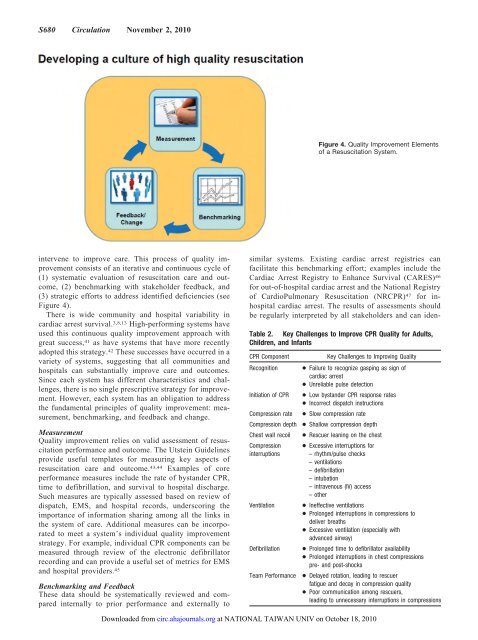2010 American Heart Association
2010 American Heart Association
2010 American Heart Association
Create successful ePaper yourself
Turn your PDF publications into a flip-book with our unique Google optimized e-Paper software.
S680 Circulation November 2, <strong>2010</strong><br />
intervene to improve care. This process of quality improvement<br />
consists of an iterative and continuous cycle of<br />
(1) systematic evaluation of resuscitation care and outcome,<br />
(2) benchmarking with stakeholder feedback, and<br />
(3) strategic efforts to address identified deficiencies (see<br />
Figure 4).<br />
There is wide community and hospital variability in<br />
cardiac arrest survival. 3,8,13 High-performing systems have<br />
used this continuous quality improvement approach with<br />
great success, 41 as have systems that have more recently<br />
adopted this strategy. 42 These successes have occurred in a<br />
variety of systems, suggesting that all communities and<br />
hospitals can substantially improve care and outcomes.<br />
Since each system has different characteristics and challenges,<br />
there is no single prescriptive strategy for improvement.<br />
However, each system has an obligation to address<br />
the fundamental principles of quality improvement: measurement,<br />
benchmarking, and feedback and change.<br />
Measurement<br />
Quality improvement relies on valid assessment of resuscitation<br />
performance and outcome. The Utstein Guidelines<br />
provide useful templates for measuring key aspects of<br />
resuscitation care and outcome. 43,44 Examples of core<br />
performance measures include the rate of bystander CPR,<br />
time to defibrillation, and survival to hospital discharge.<br />
Such measures are typically assessed based on review of<br />
dispatch, EMS, and hospital records, underscoring the<br />
importance of information sharing among all the links in<br />
the system of care. Additional measures can be incorporated<br />
to meet a system’s individual quality improvement<br />
strategy. For example, individual CPR components can be<br />
measured through review of the electronic defibrillator<br />
recording and can provide a useful set of metrics for EMS<br />
and hospital providers. 45<br />
Benchmarking and Feedback<br />
These data should be systematically reviewed and compared<br />
internally to prior performance and externally to<br />
Figure 4. Quality Improvement Elements<br />
of a Resuscitation System.<br />
similar systems. Existing cardiac arrest registries can<br />
facilitate this benchmarking effort; examples include the<br />
Cardiac Arrest Registry to Enhance Survival (CARES) 46<br />
for out-of-hospital cardiac arrest and the National Registry<br />
of CardioPulmonary Resuscitation (NRCPR) 47 for inhospital<br />
cardiac arrest. The results of assessments should<br />
be regularly interpreted by all stakeholders and can iden-<br />
Table 2. Key Challenges to Improve CPR Quality for Adults,<br />
Children, and Infants<br />
CPR Component Key Challenges to Improving Quality<br />
Recognition ● Failure to recognize gasping as sign of<br />
cardiac arrest<br />
● Unreliable pulse detection<br />
Initiation of CPR ● Low bystander CPR response rates<br />
● Incorrect dispatch instructions<br />
Compression rate ● Slow compression rate<br />
Compression depth ● Shallow compression depth<br />
Chest wall recoil ● Rescuer leaning on the chest<br />
Compression ● Excessive interruptions for<br />
interruptions – rhythm/pulse checks<br />
– ventilations<br />
– defibrillation<br />
– intubation<br />
– intravenous (IV) access<br />
– other<br />
Ventilation ● Ineffective ventilations<br />
● Prolonged interruptions in compressions to<br />
deliver breaths<br />
● Excessive ventilation (especially with<br />
advanced airway)<br />
Defibrillation ● Prolonged time to defibrillator availability<br />
● Prolonged interruptions in chest compressions<br />
pre- and post-shocks<br />
Team Performance ● Delayed rotation, leading to rescuer<br />
fatigue and decay in compression quality<br />
● Poor communication among rescuers,<br />
leading to unnecessary interruptions in compressions<br />
Downloaded from<br />
circ.ahajournals.org at NATIONAL TAIWAN UNIV on October 18, <strong>2010</strong>















